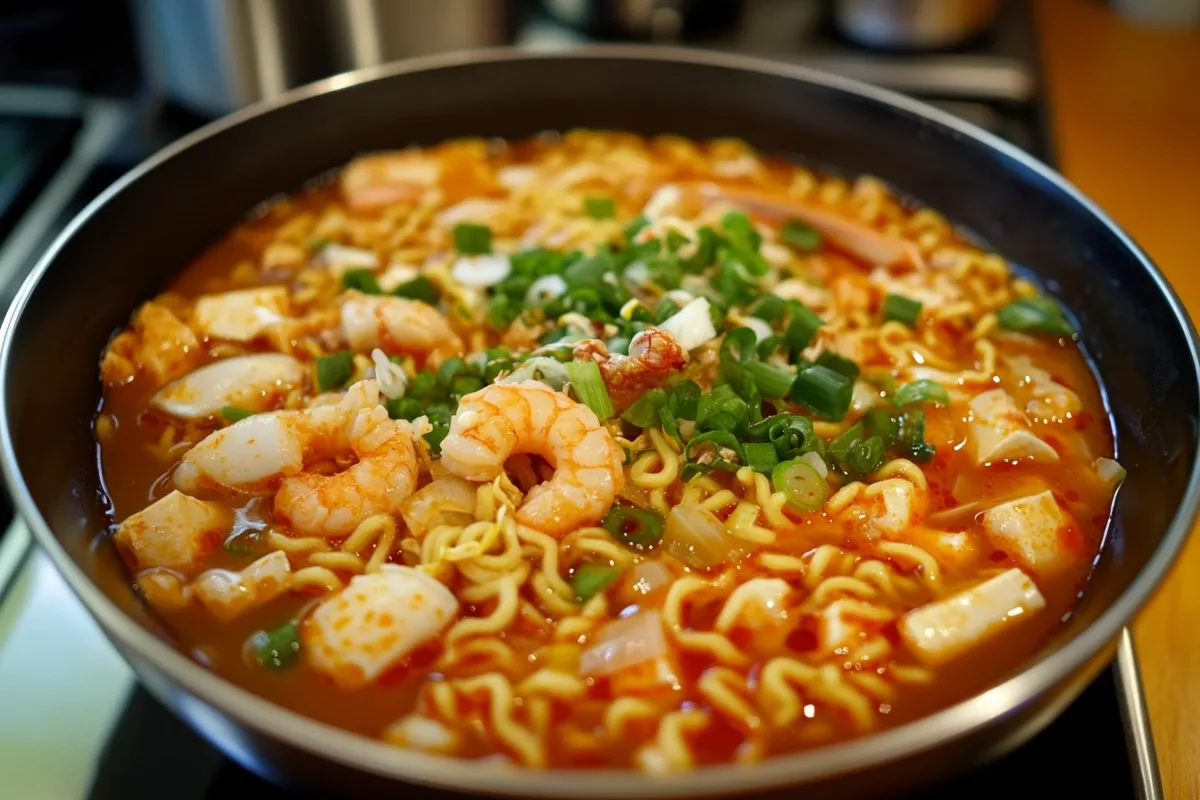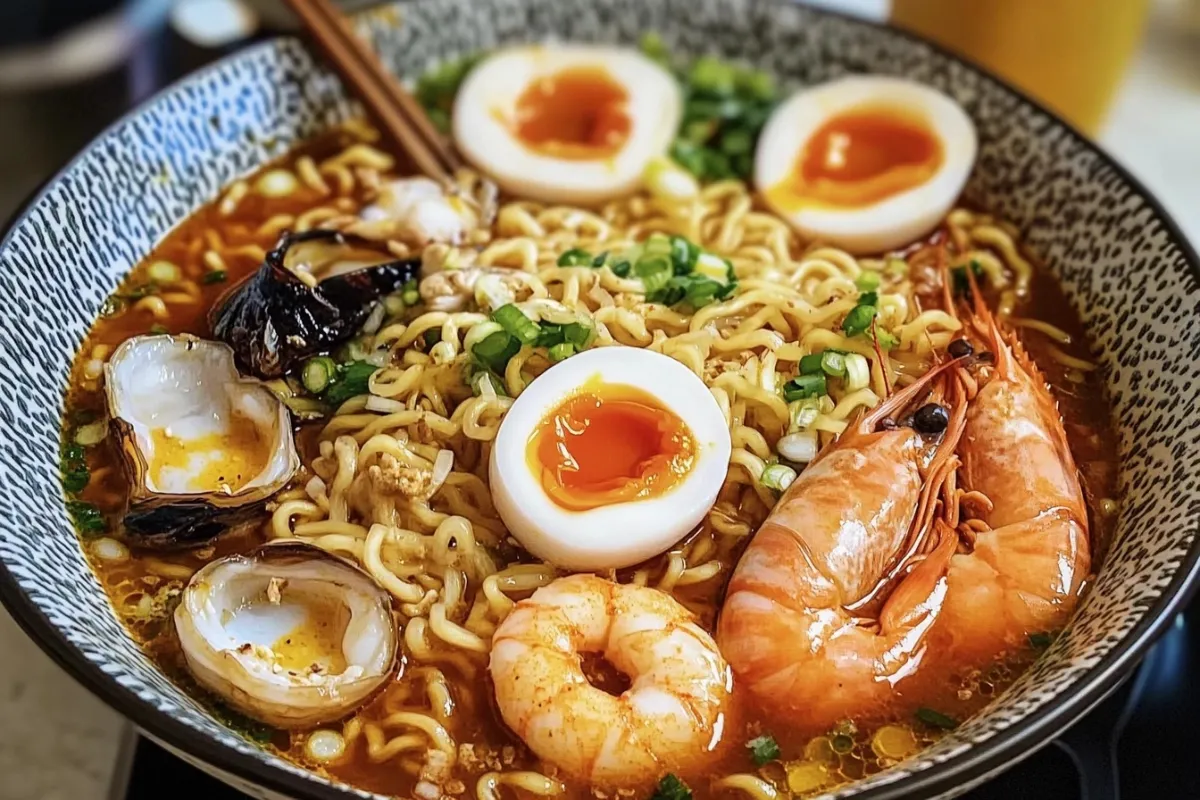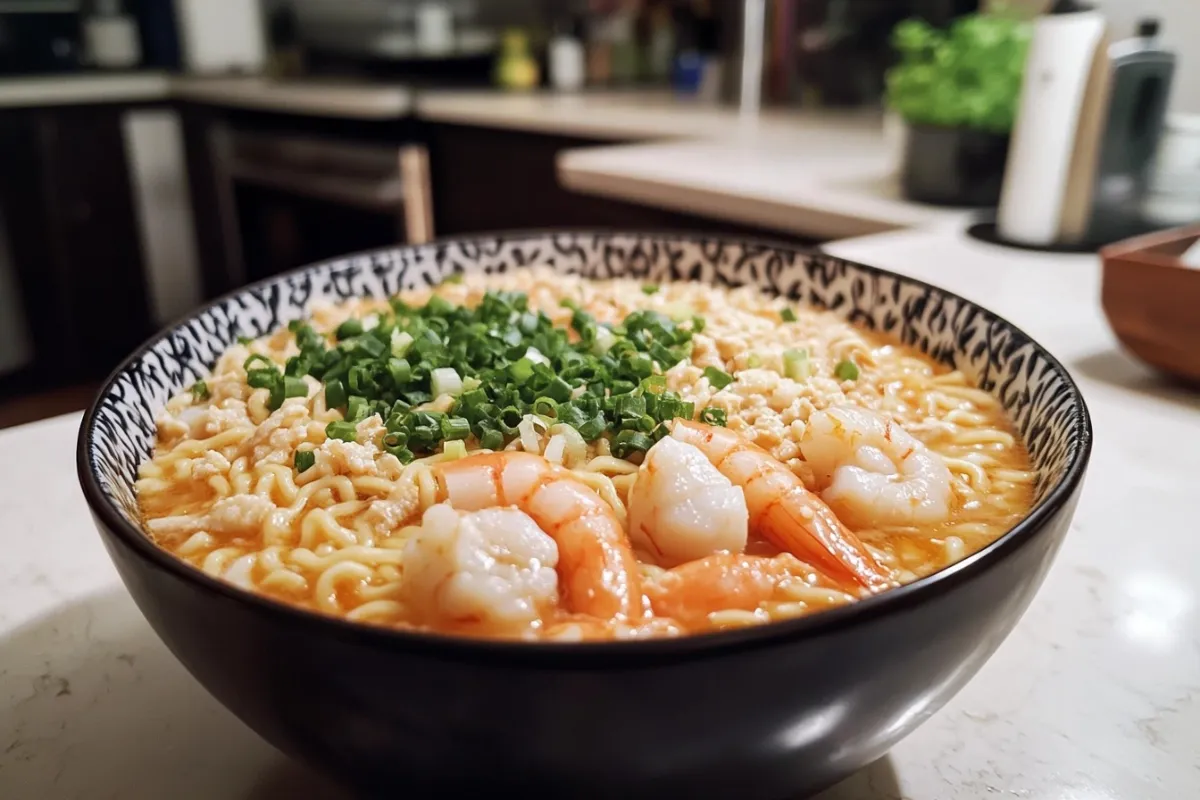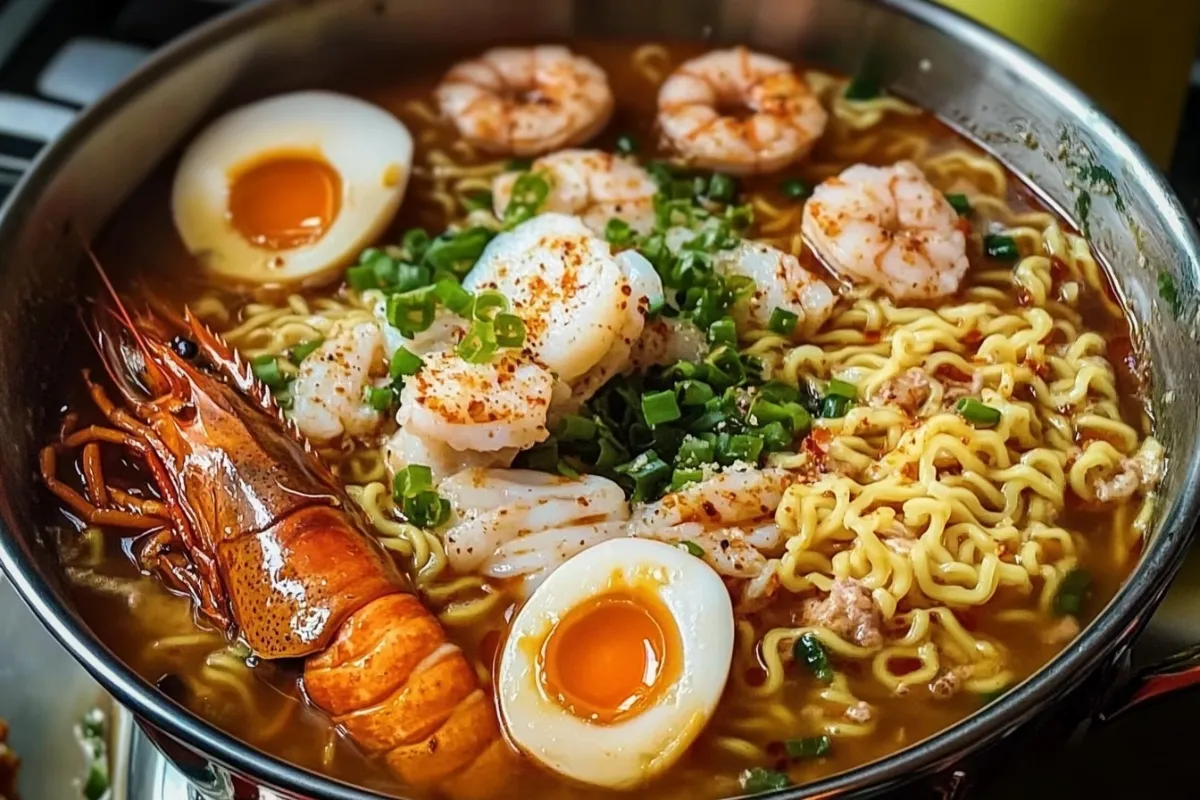Seafood ramen offers an incredibly flavorful and satisfying experience. It combines the rich umami of the sea with comforting noodles. This article explores how to make this dish at home. We will cover broths, seafood choices, and various toppings. You’ll soon master this delicious culinary adventure.
The Allure of Naturally Delicious Seafood Ramen
Seafood ramen is a delightful twist on traditional ramen. Indeed, it combines the best of land and sea. The resulting dish is a flavorful and deeply satisfying meal. This article, therefore, will guide you through each step of making this dish, from broth to toppings.
Understanding the Basics of Seafood Ramen
-
The Broth: The soul of seafood ramen is its broth. A flavorful base sets the stage for the rest of the dish. Consequently, choosing the right broth is essential.
-
The Noodles: Ramen noodles, specifically, provide the perfect texture. They complement the rich broth and seafood. Furthermore, the type of noodle matters.
-
The Seafood: A variety of naturally fresh seafood can be used. Each choice brings a unique flavor profile to the dish. Additionally, freshness is crucial.
-
The Toppings: Toppings add both flavor and texture. Consider items like soft-boiled eggs, scallions, or seaweed. Moreover, these add visual appeal.
Crafting the Perfect Broth for Seafood Ramen
The broth is indeed the foundation of any good ramen. Therefore, let’s explore broth choices for seafood ramen.
Dashi-Based Broth: A Naturally Perfect Choice
-
Dashi is a Japanese stock that is made from kelp and bonito flakes. This naturally flavorful broth provides a light yet umami-rich base. It works particularly well with the delicate flavors of seafood. Specifically, its lightness is key.
-
To make dashi, simmer kelp in water. Then, add bonito flakes and strain the broth. Accordingly, this method is traditional and simple. Also, it ensures a clear broth.
Miso-Based Broth: For a Richer Seafood Ramen Experience
-
Miso paste adds a rich and savory dimension to the broth. Furthermore, it provides a deeper flavor profile. White miso is a milder option, while red miso offers a more robust taste. Indeed, both have unique qualities.
-
To use miso, dissolve it in a bit of the hot broth before adding it to the larger pot. Consequently, this prevents clumping and ensures even distribution. Likewise, a smooth broth is desired.
Combining Broths: Creating Unique Seafood Ramen
-
Experimenting with combinations is a great way to create new flavors. For example, you can combine dashi with a touch of miso. Therefore, this fusion approach can enhance the complexity of the broth. Moreover, it allows for creativity.
Selecting the Right Seafood for Your Ramen Bowl
Choosing the right seafood is key to a delicious seafood ramen. In addition, consider the freshness and flavor profiles of each option.
Popular Seafood Choices for Ramen
-
Shrimp: Shrimp are a popular and versatile choice. They cook quickly and add a sweet, delicate flavor. Generally, they are readily available.
-
Mussels: Mussels provide a briny taste that enhances the seafood element. They are also relatively inexpensive and easy to prepare. Furthermore, their shells add to presentation.
-
Clams: Clams, similarly to mussels, add a delicious oceanic note. Their sweet and salty flavor enhances the dish. Likewise, they offer a distinct flavor.
-
Scallops: Scallops offer a more luxurious addition. Their sweet, buttery taste provides a pleasant contrast to the other seafood options. Particularly, they add a touch of elegance.
-
Squid: Squid adds a chewy texture and a mild, slightly sweet flavor. Furthermore, it absorbs the broth well. Specifically, it adds an interesting texture.
-
Crab: Crab, particularly snow crab or king crab, is a real treat. The delicate, sweet meat pairs perfectly with the broth. Ultimately, it provides a special touch.
Preparation Tips for Your Seafood Ramen
-
Ensure all seafood is fresh or properly thawed. Afterward, rinse and pat the seafood dry before cooking. Therefore, this ensures better cooking.
-
Do not overcook the seafood. Overcooked seafood becomes rubbery and loses its flavor. Add it toward the end of the cooking process. Hence, timing is essential.
-
Consider pre-cooking certain seafood items before adding them to the broth. Specifically, this helps to control the cooking time and prevent overcooking. Also, this ensures optimal texture.
Essential Noodles for Authentic Seafood Ramen
The right type of noodle is crucial for a great bowl of seafood ramen. Specifically, different noodles offer varying textures and flavors. Thus, noodle selection is key.
Understanding Ramen Noodles
-
Ramen noodles are typically made from wheat flour, water, salt, and kansui (an alkaline solution). This combination gives them a unique springy and chewy texture. Indeed, this is what gives them their unique qualities.
-
Indeed, ramen noodles come in various shapes and thicknesses. Thin noodles are suitable for lighter broths, while thicker ones work well with richer broths. Accordingly, matching noodle to broth is important.
Fresh Versus Dried Ramen Noodles
-
Fresh ramen noodles have a more delicate texture and tend to cook faster. Generally, they are a better option if available. Moreover, they offer superior quality.
-
Dried ramen noodles are more convenient and readily available. Cook them according to package directions and rinse them with cold water. However, they still provide good results.
Cooking Noodles for Seafood Ramen
-
Cook noodles separately. Thus, this prevents the broth from becoming starchy. Therefore, this keeps the broth clear.
-
Cook the noodles until they are al dente. Do not overcook the noodles. Subsequently, they will become too soft. Likewise, achieving the right texture is vital.
-
Rinse the cooked noodles under cold water. Accordingly, this halts the cooking process and removes excess starch. Specifically, this stops them from overcooking.
Flavor Enhancements for Seafood Ramen
Flavorings and aromatics take your seafood ramen to another level. These elements add depth and complexity. Furthermore, they are key to a flavorful dish.
Aromatic Additions
-
Garlic: Minced or pressed garlic provides a strong, pungent aroma. Sauté it briefly before adding it to the broth. In particular, sauteing enhances the flavor.
-
Ginger: Fresh ginger adds a warm and spicy note. Slice or grate it for maximum flavor. Consequently, grating releases its aromas.
-
Scallions: Scallions, or green onions, add a fresh, mild onion flavor. Slice them thinly and use them as a topping. Also, they add a nice visual element.
Essential Flavor Boosters for Naturally Delicious Results
-
Soy Sauce: Soy sauce adds saltiness and umami. Use a high-quality brand for the best flavor. Specifically, a good soy sauce is crucial.
-
Mirin: Mirin, a sweet rice wine, adds a touch of sweetness. It also balances out the other flavors. Also, it adds depth.
-
Sesame Oil: Toasted sesame oil adds a nutty aroma and a rich flavor. Drizzle a small amount on top just before serving. Furthermore, it adds a nice aroma.
-
Chili Oil: Chili oil adds a spicy kick to the ramen. Add a bit or more to taste. However, use according to preference.
Exciting Toppings for Your Seafood Ramen Bowl
Toppings add visual appeal, flavor, and texture to your ramen. Here are some popular options for seafood ramen. Moreover, they make the dish more exciting.
Classic Ramen Toppings
-
Soft-Boiled Eggs: Soft-boiled eggs add a creamy richness. Marinate the eggs in soy sauce for an even better flavor. Indeed, a marinated egg enhances flavor.
-
Nori Seaweed: Nori adds a salty, briny flavor and a satisfying crunch. Use pre-cut strips or cut sheets into smaller pieces. Accordingly, it adds a distinct taste.
-
Bamboo Shoots: Bamboo shoots add a slightly sweet and crunchy texture. Generally, they are available in cans or jars. Specifically, they provide a nice crunch.
Additional Toppings to Enhance Your Seafood Ramen
-
Spinach or Bok Choy: Leafy greens add color and nutrients to the ramen. Blanch or stir-fry them lightly before adding to the bowl. Additionally, they add a health benefit.
-
Corn: Sweet corn adds a burst of sweetness. Use fresh, frozen, or canned corn. Also, this provides a sweet contrast.
-
Bean Sprouts: Bean sprouts provide a crunchy texture. Therefore, they can be added raw or lightly stir-fried. Moreover, they add a satisfying crunch.
-
Fish Cake (Kamaboko): Fish cake adds a unique texture and flavor. It can be found in Asian grocery stores. Thus, consider adding for authenticity.
Step-by-Step Guide: Preparing Seafood Ramen
Now, let’s look at a comprehensive step-by-step guide for preparing seafood ramen. Specifically, this will guide you through the process.
Step 1: Preparing the Broth
-
Start by making your dashi or chosen broth base. Then, this provides the foundation.
-
Next, add your aromatics, such as garlic and ginger. Subsequently, this adds depth of flavor.
-
Then, add soy sauce, mirin, and any other flavor enhancers. Therefore, this balances all flavors.
-
Simmer the broth while preparing other ingredients. Meanwhile, other elements are prepared.
Step 2: Preparing the Seafood
-
First, ensure all seafood is clean and prepped. Indeed, this step is crucial.
-
Afterward, you can pre-cook seafood, like shrimp or scallops. Thus, this helps control cooking time.
-
Therefore, lightly sauté seafood before adding to the bowl. Furthermore, this enhances the flavor.
Step 3: Cooking the Noodles
-
Cook ramen noodles in a separate pot. Consequently, the broth remains clear.
-
Next, ensure they are cooked to al dente. Specifically, avoid overcooking.
-
Subsequently, rinse the noodles in cold water. Also, this stops the cooking process.
Step 4: Assembling Your Seafood Ramen Bowl
-
Place the cooked noodles in a bowl. Then, they are ready for the broth.
-
Then, add the hot broth. Therefore, this is the base of the ramen.
-
Afterwards, carefully arrange the seafood, toppings, and flavorings. In addition, this makes it visually appealing.
-
Serve immediately and enjoy your bowl of seafood ramen. Finally, savor the dish immediately.
Table 1: Common Seafood and Their Flavor Profiles
| Seafood | Flavor Profile | Texture | Preparation Notes |
| Shrimp | Sweet, Delicate | Tender | Cook quickly; avoid overcooking |
| Mussels | Briny, Oceanic | Slightly Chewy | Steam or simmer until shells open |
| Clams | Sweet, Salty | Tender, Slightly Chewy | Steam or simmer until shells open |
| Scallops | Sweet, Buttery | Tender | Sear or sauté quickly; avoid overcooking |
| Squid | Mild, Slightly Sweet | Chewy | Cook quickly or slowly to avoid rubbery texture |
| Crab | Delicate, Sweet | Tender | Cooked; add at the end to maintain texture and flavor |
Table 2: Common Seafood Ramen Toppings
| Topping | Flavor Profile | Texture | Preparation Notes |
| Soft-Boiled Egg | Creamy, Savory | Soft, Gooey | Marinate in soy sauce for extra flavor |
| Nori Seaweed | Salty, Briny | Crisp | Use as a garnish or wrap around noodles |
| Bamboo Shoots | Slightly Sweet, Earthy | Crunchy | Canned; ready to use after rinsing |
| Spinach/Bok Choy | Mild, Earthy | Tender, Slightly Crunchy | Blanch or stir-fry lightly |
| Corn | Sweet | Juicy | Use fresh, frozen, or canned; add at the end |
| Bean Sprouts | Fresh, Mild | Crunchy | Can be added raw or lightly stir-fried |
| Fish Cake | Savory, Mild | Chewy | Add as is or slightly warmed |
Variations and Customizations for Seafood Ramen
Seafood ramen can be customized to suit individual tastes. Here are some ideas for variations. Additionally, experimentation is key.
Spicy Seafood Ramen
-
Add a generous amount of chili oil or gochujang (Korean chili paste). Therefore, this adds a fiery kick to the broth. Moreover, it enhances flavor.
-
Use a spicy miso paste. Furthermore, this can add an extra layer of heat. Similarly, consider adding spicy ingredients.
Creamy Seafood Ramen
-
Add a bit of coconut milk. Similarly, this makes the broth creamy and richer. Thus, it adds a rich texture.
-
Mix in a spoonful of heavy cream or Japanese mayo for added richness. In particular, this enhances creaminess.
Vegetarian Seafood Ramen
-
Use a vegetable broth instead of dashi. Additionally, you can add umami with dried mushrooms or kelp. Furthermore, it maintains the umami taste.
-
Include plant-based seafood alternatives, such as tofu or jackfruit. Indeed, these provide different textures.
Experimenting with Different Seafood Combinations
-
Try different combinations of seafood. For example, shrimp and scallops work well together. Also, it allows for creativity.
-
Add different types of shellfish, such as oysters or periwinkles. Specifically, it offers unique flavors.
Health Benefits of Seafood Ramen
Seafood ramen, while delicious, can also offer several health benefits. Specifically, it can be a healthy choice.
Nutritional Advantages
-
Seafood is rich in protein, omega-3 fatty acids, and essential minerals. These nutrients are vital for overall health. Therefore, this dish is nutritious.
-
Noodles provide carbohydrates that offer energy. Furthermore, vegetables add fiber and vitamins. Additionally, it provides a balanced meal.
Moderation is Key for Naturally Balanced Eating
-
Be mindful of sodium content. Using low-sodium broth and soy sauce is an excellent option. Specifically, this will manage sodium intake.
-
Choose fresh and naturally healthy ingredients. Specifically, this maximizes the nutritional benefits. Indeed, this will enhance the benefits.
Adjusting Portion Sizes for Naturally Healthier Eating
-
Be conscious of portion sizes. Indeed, this helps to maintain a balanced diet. Thus, portion control is crucial.
-
Focus on a balanced meal with seafood, noodles, and a variety of vegetables. Additionally, this contributes to balanced nutrition.
Tips for the Perfect Seafood Ramen Every Time
-
Use the freshest ingredients for the best results. Indeed, this is vital for flavor.
-
Taste and adjust seasonings as needed. Furthermore, personalize the dish.
-
Serve immediately to prevent the noodles from overcooking. Also, this will ensure the best texture.
-
Don’t be afraid to experiment and have fun. Moreover, creativity is encouraged.
Frequently Asked Questions about Seafood Ramen
Is seafood ramen a thing?
Yes, seafood ramen is a popular variation of traditional ramen. It incorporates various types of seafood in the broth and as toppings. It is a delicious and flavorful way to enjoy ramen.
What broth is used in seafood ramen?
Common broths for seafood ramen include dashi, a Japanese fish stock, and miso-based broths. You can also use a combination of the two. These broths complement the flavors of the seafood well.
What fish goes well with ramen?
Many types of fish and seafood pair well with ramen. Popular choices include shrimp, scallops, mussels, clams, and squid. Each provides unique flavors that enhance the dish.
What is seafood Ramyun?
Seafood Ramyun is a Korean instant noodle dish that includes seafood. It’s similar to seafood ramen in concept. However, it often uses spicier broths and different types of noodles.
Conclusion
In conclusion, seafood ramen is an incredibly versatile and flavorful dish. It combines the richness of the sea with the comfort of noodles. Thus, by experimenting with different broths, seafood, and toppings, you can create endless variations. Moreover, this dish is not only delicious but also nutritious, offering a great source of protein and omega-3 fatty acids. Indeed, by following the tips and steps outlined in this article, you’ll be able to prepare an outstanding seafood ramen. Ultimately, don’t hesitate to adapt the recipe to your personal tastes. Consequently, you will discover the joy of savoring a homemade bowl of seafood ramen. So, go ahead and enjoy this seafood culinary adventure. Effectively, each bite will be a discovery. Furthermore, this dish has the potential to become one of your favorites. Therefore, dive in and enjoy this marine-inspired culinary delight.



